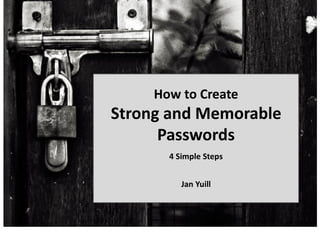Create Strong and Memorable Passwords: 4 Simple Steps
- 1. How to Create Strong and Memorable Passwords 4 Simple Steps Jan Yuill
- 2. General Rules for Creating Strong Passwords • Use made-up words, not found in a dictionary. • Use a combination of letters (upper and lower case), numbers, and special characters. • The more characters you use, the better (at least 8). • Use unique passwords for each account. • Change passwords frequently.
- 3. Step 1 Create a memorable base password.
- 4. To create a memorable base password, choose a statement that is true for you.
- 5. It may be an expression or personal goal or quote...
- 7. “I love my kids.” -or- “Let’s go to Disneyland.” -or- “To thine own self be true.”
- 8. Step 2 Now change the base password.
- 9. No.
- 11. Write your memorable statement on a piece of paper. We’ll use this one as an example… I love my kids.
- 12. Now play with ľ±łŮ…
- 13. I love my kids. 1<3MiKdz!Replace the word “I” with a “1.”
- 14. I love my kids. 1<3MiKdz! Replace the word “love” with its emoticon symbol “<3.” Yup. Typing a < followed by a 3 in a text message on your cell phone is transformed into a  Sweet.
- 15. I love my kids. 1<3MiKdz! Replace the word my with Mi.
- 16. I love my kids. 1<3MiKdz! Replace the word kids with Kdz.
- 17. I love my kids. 1<3MiKdz! Replace the period with an exclamation mark.
- 18. This is a strong base password. 1<3MiKdz! You’re not going to find it in any dictionary!
- 19. Use letters, numbers, symbols, and punctuation to replace the actual spelling and appearance of your memorable phrase.
- 20. But don’t change it so much that you forget what it is! Keep it memorable.
- 21. Step 3 Now add identifiers for each account that needs a password.
- 22. You might add a prefix: • “fb” for your Facebook account; • “tw” for your Twitter account; and • “bk” for your online banking like this…
- 24. The password for each account contains the same core, but has a unique identifier.
- 25. Step 4 Now add a date identifier.
- 26. Decide when you will change your passwords. Annually? Quarterly? Monthly?
- 27. For example, if you plan to change your passwords quarterly, you may add the year and month to your password...
- 28. forFacebook f b 1 < 3 M i Kd z ! 1 4 a p forTwitter t w 1 < 3 M i Kd z ! 1 4 j u foryourBank b k 1 < 3 M i Kd z ! 1 4 o c 14 is for the year 2014 and ap is for the month of April oc for October ju is for July
- 29. This is an example of a very simple pattern. Make your pattern something not easily guessed by someone else.
- 30. And finally…
- 31. Some people recommend using a password manager, like… LastPass 1Password Roboform
- 32. I’m not one of them… yet.
- 33. Others recommend never writing your passwords down.
- 34. I’m not one of them either.
- 35. In fact, if something were to happen to you, how would anyone know what to do with your accounts?
- 36. I recommend that you: • Write or print the password details for each of your accounts. • Keep them in a secure place (with your will perhaps) where your executor can find them. • Don’t share your passwords with anyone. • Avoid logging in to public computers. (Always clear the browsing history, if you do.) • Replace your weak passwords with your new strong and memorable ones ASAP!
- 37. These are some good articles about creating strong and memorable passwords: https://support.mozilla.org/en-US/kb/create-secure-passwords-keep-your-identity-safe http://www.thegeekstuff.com/2008/06/the-ultimate-guide-for-creating-strong-passwords/ http://safeandsavvy.f-secure.com/2010/03/15/how-to-create-and-remember-strong-passwords/ http://wolfram.org/writing/howto/password.html
- 38. Jan Yuill Thank you, Sippanont Samchai for the use of your photo.






































